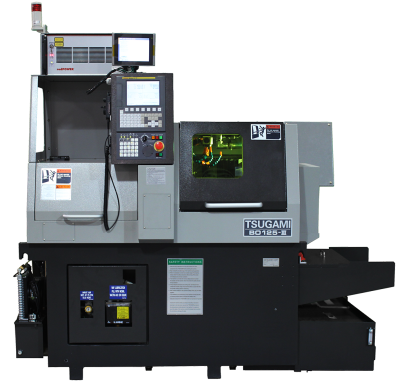
The new LaserSwiss is a Tsugami B0125-III with a fully integrated laser cutting system. The compact, 12 mm, 5-axis Swiss-style CNC lathe is the smallest LaserSwiss the company offers.
“This machine has a tiny footprint,” Tsugami LaserSwiss Business Development Director Dan Walker said, “and it’s our most economical model. It perfectly complements our product line.”
According to Walker, the company designed the B0125 LaserSwiss for shops that typically perform tube cutting operations with standard tube cutting machines. “The B0125 gives those shop owners more capability,” he said. “In addition to laser tube cutting, they’ll be able to perform turning operations, like adding a chamfer, without having to move the part to another machine or outsourcing those operations.”
The B0125 is the only 12 mm machine on the market that combines Swiss turning and laser cutting within a fully integrated platform. It has 10 tool positions in addition to the laser, and it’s convertible, meaning it can be run as a traditional Swiss style lathe using a guide bushing or operated with an optional chucker kit, which can be installed in minutes. “This machine offers tremendous flexibility,” Walker noted.
Tsugami LaserSwiss also offers an assortment of 20 mm and 32 mm machines with linear axes ranging from three to seven. Available models include B-axis capability, and a second laser head for welding.
“We’re trying to give manufacturers multiple machining options so they can get precisely what they need without going overboard,” Walker said. “If they’re making relatively simple parts, a 3-axis machine might be all they need. If they’re doing very complex work, they might make use of all of the features of a 7-axis machine. Our mission is to continue making the LaserSwiss incrementally scalable to meet everyone’s needs.”
Tsugami LaserSwiss machines are available with laser watts ranging from 200W to 500W. All laser operations are programmed and driven from the machine’s FANUC 0iTF control and the laser’s frequency, pulse width, focus and power are on-the-fly adjustable.
Contact Details
Related Glossary Terms
- bushing
bushing
Cylindrical sleeve, typically made from high-grade tool steel, inserted into a jig fixture to guide cutting tools. There are three main types: renewable, used in liners that in turn are installed in the jig; press-fit, installed directly in the jig for short production runs; and liner (or master), installed permanently in a jig to receive renewable bushing.
- computer numerical control ( CNC)
computer numerical control ( CNC)
Microprocessor-based controller dedicated to a machine tool that permits the creation or modification of parts. Programmed numerical control activates the machine’s servos and spindle drives and controls the various machining operations. See DNC, direct numerical control; NC, numerical control.
- lathe
lathe
Turning machine capable of sawing, milling, grinding, gear-cutting, drilling, reaming, boring, threading, facing, chamfering, grooving, knurling, spinning, parting, necking, taper-cutting, and cam- and eccentric-cutting, as well as step- and straight-turning. Comes in a variety of forms, ranging from manual to semiautomatic to fully automatic, with major types being engine lathes, turning and contouring lathes, turret lathes and numerical-control lathes. The engine lathe consists of a headstock and spindle, tailstock, bed, carriage (complete with apron) and cross slides. Features include gear- (speed) and feed-selector levers, toolpost, compound rest, lead screw and reversing lead screw, threading dial and rapid-traverse lever. Special lathe types include through-the-spindle, camshaft and crankshaft, brake drum and rotor, spinning and gun-barrel machines. Toolroom and bench lathes are used for precision work; the former for tool-and-die work and similar tasks, the latter for small workpieces (instruments, watches), normally without a power feed. Models are typically designated according to their “swing,” or the largest-diameter workpiece that can be rotated; bed length, or the distance between centers; and horsepower generated. See turning machine.
- turning
turning
Workpiece is held in a chuck, mounted on a face plate or secured between centers and rotated while a cutting tool, normally a single-point tool, is fed into it along its periphery or across its end or face. Takes the form of straight turning (cutting along the periphery of the workpiece); taper turning (creating a taper); step turning (turning different-size diameters on the same work); chamfering (beveling an edge or shoulder); facing (cutting on an end); turning threads (usually external but can be internal); roughing (high-volume metal removal); and finishing (final light cuts). Performed on lathes, turning centers, chucking machines, automatic screw machines and similar machines.
